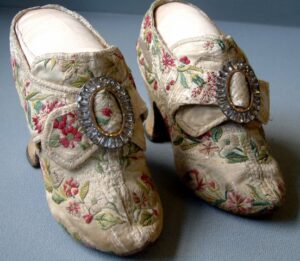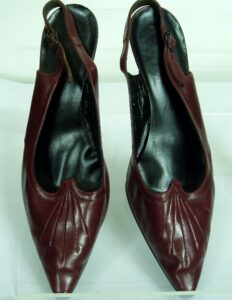From comfy slippers to favourite party shoes, footwear is often seen as the embodiment of a person’s character. It is also the article of dress which tends to mould most closely to our body and reflect our habits, so intimately connected to a particular person, maintaining their shape and their essence when they have gone.

Concealed shoe found between wall of Plaza and Williams and Glyn’s Bank, Newbury.
Perhaps for this reason, shoes are one of the commonest items to be found concealed in old buildings. There are various interpretations for this ritual from an attempt to ward off evil, to offer the protection of the person whose shoe it was, from curses, memorialisation’s and just carelessness in losing an object, although as shoes were expensive items and worn and recycled until unwearable, this is unlikely for historical shoes. One late seventeenth/early eighteenth century shoe was found in the wall between the Plaza Cinema and William and Glyn’s Bank in the Market Place, Newbury, during demolition, a not unusual place for a concealed shoe. Its purpose is not clear, but the shoe is fascinating. A man’s leather shoe, it has latchets over the front, straps which would have been secured and adjustable with a buckle. It is a fairly every-day shoe, plain, with a low heel, as was fashionable along with the square toe, and nails on the sole to make it more hard-wearing.

Ladies shoes, silk embroidered with flowers, mid-18th century.
This type of shoe construction, with latchets and buckle, continued for most of the eighteenth century for both male and female shoes. In the museum’s collection is a pair of elite ladies shoes, the upper of cream silk embroidered with flowers. Dating from the mid-eighteenth century, they have a high shaped, or Louis heel, and pointed upturned toes. Displayed with later paste buckles, this shows how they would have been fastened.
Until the mid-nineteenth century, shoes were usually made as straights, that is neither left nor right, so only requiring one last to shape them when being made. The wearer chose which foot to wear them on and shoes gradually became shaped to that foot. This is particularly visible with a slipper type of shoe, a style popular from the very end of the eighteenth century and throughout the nineteenth century.

Ladies shoes, black glacé kid with a small Louis heel, c1880.
This pair of black glacé kid, echoes styles from earlier in the century, commonly decorated with a bow, but here with a small Louis heel so actually dating from around 1880. As they are less used, decorative evening shoes tend to be a type which survive and often end up in museum collections such as the Edwardian pair made in Vienna for the London store Harrods, the cream satin embroidered and beaded, with diamond shaped cut-outs down the vamp.

Ladies shoes, made in Vienna for Harrods, Edwardian.

Ladies walking shoes by ‘Moykopf’, 1930s.
Shoe fashions within the last century, continue to influence footwear designers today. The two tone ‘co-respondent’ style is immediately identifiable as a ladies walking shoe from the 1930s, this pair from the high class shoemaker ‘Moykopf’, who ran a business from the Burlington Arcade in London from 1852 to 1951. Fastened with tasselled laces across the instep, such stylistic elements continue to inform shoe design today.

Ladies shoes produced under the Utility Scheme, CC41, 1940s.
Likewise, in a startling lime colour, these ladies shoes were produced under the Utility Scheme, CC41 (Clothing Control 1941), introduced in 1941 during the Second World War. Design was pared back, with simplicity and no superfluous trimmings, interest achieved with pinking, giving zig-zag edges, and shaping the panels of the felt uppers.

Ladies stiletto heel shoes, mid-1950s.
Also associated in particular with the 1950s, but still current today, is the stiletto heel, named after a thin, sharp Italian dagger, and showing the influence of Italian fashions during that decade. The museum holds a collection of ladies stiletto heel shoes from the mid-1950s, this pair of maroon coloured leather with pointed toes and sling backs, made by Bally, originally a Swiss company who are still in existence today.
Shoes are both a necessity and reveal much about the person who is wearing them, perhaps sometimes things which a wearer might not think they are exposing. As such, they are great to study both historically and on people’s feet in the street today!
Researched and written by Alison Toplis, Museum Volunteer.







